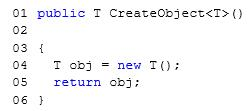READ Free Dumps For Microsoft- 70-483
| Question ID 17100 | You are writing the following method (line numbers are included for reference only):

You need to ensure that CreateObject compiles successfully.
What should you do?
|
| Option A | Insert the following code at line 02: where T : new()
|
| Option B | Replace line 01 with the following code: public void CreateObject<T>()
|
| Option C | Replace line 01 with the following code: public Object CreateObject<T>()
|
| Option D | Insert the following code at line 02: where T : Object
|
| Correct Answer | A |
Explanation
| Question ID 17101 | You are implementing a new method named ProcessData. The ProcessData() method
calls a third-party component that performs a long-running operation.
The third-party component uses the IAsyncResult pattern to signal completion of the long-
running operation.
You need to ensure that the calling code handles the long-running operation as a
System.Threading.Tasks.Task object.
Which two actions should you perform? (Each correct answer presents part of the solution.
Choose two.)
|
| Option A | Call the component by using the TaskFactory.FromAsync() method.
|
| Option B | Create a TaskCompletionSource<T> object.
|
| Option C | Apply the async modifier to the method signature.
|
| Option D | Apply the following attribute to the method signature: [MethodImpl(MethodImplOptions.Synchronized)]
|
| Correct Answer | A,B |
Explanation Explanation: A: TaskFactory.FromAsync Method Creates a Task that represents a pair of begin and end methods that conform to the Asynchronous Programming Model pattern. Overloaded. Example: TaskFactory.FromAsync Method (IAsyncResult, Action
) Creates a Task that executes an end method action when a specified IAsyncResult completes. B: In many scenarios, it is useful to enable a Task to represent an external asynchronous operation. TaskCompletionSource is provided for this purpose. It enables the creation of a task that can be handed out to consumers, and those consumers can use the members of the task as they would any other. However, unlike most tasks, the state of a task created by a TaskCompletionSource is controlled explicitly by the methods on TaskCompletionSource. This enables the completion of the external asynchronous operation to be propagated to the underlying Task. The separation also ensures that consumers are not able to transition the state without access to the corresponding TaskCompletionSource. Note: * System.Threading.Tasks.Task Represents an asynchronous operation.
